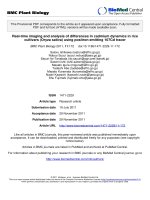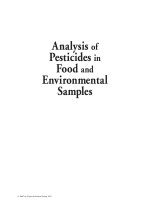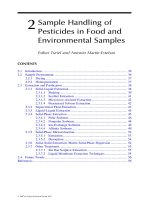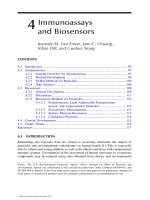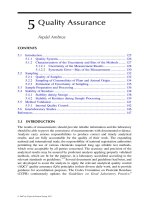Trend analysis of area, production and productivity of Cherry in Jammu and Kashmir
Bạn đang xem bản rút gọn của tài liệu. Xem và tải ngay bản đầy đủ của tài liệu tại đây (523.98 KB, 10 trang )
Int.J.Curr.Microbiol.App.Sci (2019) 8(2): 2135-2144
International Journal of Current Microbiology and Applied Sciences
ISSN: 2319-7706 Volume 8 Number 02 (2019)
Journal homepage:
Original Research Article
/>
Trend Analysis of Area, Production and Productivity of
Cherry in Jammu and Kashmir
Yasmeena Ismail1*, S.A. Mir1, Nageena Nazir1, M.H. Wani2,
S.A. Wani2 and M.S. Pukhta1
1
Division of agricultural statistics, 2Division of Agri-Economics and HBM, Sher-e-Kashmir
University of Agricultural Sciences and Technology-Kashmir, India
*Corresponding author
ABSTRACT
Keywords
Cherry, Trend
analysis, Parametric
regression,
Nonparametric
regression
Article Info
Accepted:
18 January 2019
Available Online:
10 February 2019
Cherry (Prunus avium) is one of the important horticultural crops grown in Jammu and
Kashmir and is packed with healthy nutrients and excellent antioxidants. Basically,
cherries are native to Europe and Asia regions. Cherries are cultivated all over the world
and the top 3 producers of cherry are Turkey, USA and Iran. India occupies as 26 th
producer in the list. In India, cherry commercial cultivation is carried in the states of
Himachal Pradesh, Jammu and Kashmir and Uttar Pradesh due to suitable climate. The
present study is an attempt to find past trends of cherry in Jammu and Kashmir using
parametric, nonparametric and semi-parametric regression methods. The performance of
each method is compared using higher values of R2 and lower values of residual criteria. It
is found that the nonparametric/semi-parametric regression comes out to be good fit for
trends in cherry production in comparison to the parametric regression. Even semiparametric spline regression is selected as the best fitted model for trend analysis. It is
inferred that the area under cherry cultivation in Jammu and Kashmir is increasing from
1974-2017 and the productivity has also shown an increasing trend except for some recent
years where the trend is found declining. The study advocates for researchers technological
breakthrough in cherry production in Jammu and Kashmir.
Introduction
Cherries are one of the most important
deciduous fruit as well as ornamental crop
worldwide. In India, Cherries are mainly
grown in the North-Western Himalayan
region in the altitude range of 2,000 to 2,700
m above sea-level and require 1,000 - 1,500 h
chilling period during winters. Climate of
Jammu and Kashmir (J&K), high hills of
Himachal Pradesh (H.P.) and Uttarakhand is
ideal for its commercial cultivation. In
Kashmir Harwan, Dara, Kangan, Shopian,
Tangmarg, are the main areas where cherries
are grown. The main cherry varieties grown
in J&K are Black Heart, Early Purple Black
Heart, Guigne Noir Gross Lucenta, Guigne
Noir Hative, Guigne Pour ova Precece,
Bigarreau Napoleon and Bigarreau Noir
Gross; whereas in H.P. Black Tartarian, Bing,
2135
Int.J.Curr.Microbiol.App.Sci (2019) 8(2): 2135-2144
Napoleon White, Sam, Sue, Stella, Van,
Lambert, Black Republican, Pink Early,
White Heart, Early Rivers, Nirodiro, Black
heart, Cherry Red Sweet heart and Lambert
are under cultivation. Bedford Prolific, Black
Heart and Governor’s Wood varieties are
mainly cultivated in Uttarakhand.
The growth rates of crops are mostly
estimated by the linear regression models. But
there are instances where the linear regression
models do not fit the data well. Under such
situations it is essential to look for an
alternative. The nonparametric and semiparametric approaches are more flexible in
such situations. These approaches are
particularly useful when little past experience
is available. In last few years, nonparametric
regression and semi-parametric regression
technique for functional estimation has
become increasingly popular as a tool for data
analysis. These techniques impose only few
assumptions about shape of function and
therefore it is more flexible than usual
parametric regression approaches. Smoothing
techniques are commonly used to estimate the
function non-parametrically (Härdle 1990).
Nonparametric regression models avoid
restrictive assumptions of the functional form
of the regression function. Semi-parametric
regression model combine the components of
parametric and nonparametric regression
models, by keeping the easy interpretability of
the former and retains some of the flexibility
of the latter. Various scientists viz.,
(Chandran 2004) has applied nonparametric
regression to study the growth rates of total
foodgrain production of India during the
period 1987 to 2001. Teczan (2010) has
studied
the
nonparametric
regression
technique to find out the growth rate trends of
various crops. Sahu and Pal (2004) used
nonparametric regression (Lowess) and semiparametric (spline) for modeling of pest
incidences. (Dhekale, Sahu, Vishwajith,
Mishra and Narsimhaiah 2017) employed the
nonparametric regression model to study the
trends of tea in India. The current study is
aimed to develop appropriate parametric and
nonparametric regression models to fit the
trends in area, production and productivity.
(Ismail, Mir and Nazir 2018) has utilized the
nonparametric and semi-parametric regression
models for modeling the trends in area,
production and productivity of apple in
Jammu and Kashmir.
Materials and Methods
For present study, to study the trends and
growth rates, long term data for last 43 years
pertaining to the area, production and
productivity of cherry is collected from
Directorate of Horticulture. The descriptive
measures of central tendency and dispersions
along with the simple and compound growth
rates are used to explain the features of the
data (Mishra, Sahu, Bajpai and Nirnjan 2012).
Trend models
Parametric regression models
To find out the path of the production process
different parametric trend models are fitted.
Among the fitted models, the best model is
selected on the basis of their goodness of fit
(R2) value and significance of the coefficients.
The dependent variable Y is area, production
and productivity of cherry and independent
variable X is the time points (years) from
1974 to 2017.
Nonparametric
and
regression models
Semi-parametric
The model considered here is of the form
Yi m( xi ) i , xi i / n, i 1,2,...n
Where, Yi is observation of i th time point,
m() is trend function which is assumed to be
smooth and i are random errors with mean
2136
Int.J.Curr.Microbiol.App.Sci (2019) 8(2): 2135-2144
zero and finite variance. Since there is no
assumption
of
parametric
form
of
function m() , this approach is flexible and
robust to deviations from an assumed model
form. To obtain an estimate of the mean
response value at a point X, most of the
smoothers are averaging the Y – values of
observations having predictor values closer to
the target value X. The averaging is done in
neighborhoods around target value. The main
decision to be made in any of the smoothing
techniques is to fix the size of neighborhood
which is typically expressed in terms of an
adjustable smoothing parameter or bandwidth.
Intuitively, large neighborhoods will provide
an estimate with low variance but potentially
high bias, and conversely for small
neighborhoods.
The first term is the sum of squares of the
residuals; it provides a measure of how well
the function m fits the data. The integral of
the above equation is a measure for the
roughness/smoothness of the function m . The
functions which are highly curved will result
in a large value of the integral; straight lines
result in the integral being zero.
Lowess regression, introduced by Cleveland
(1979), is obtained on the basis of the data
points around it within a band of certain
width. The point xi is the midpoint of the
band. The data points within the band are
assigned weights in a way so that xi has the
highest weight. The weights for the other data
points decline with their distance from xi
according to a weight function. The weighted
least squares method is used to find the fitted
value corresponding to xi, which is taken as
the smoothed value. The procedure is
repeated for all the data points. The spline
method of estimation make use of the
penalized least squares method (Simonoff
2012), which balances the fitting of the data
closely. The objective is to estimate m by
means of a function that fits the data well and
is as smooth as possible. A measure of
smoothness of m is the integral of the square
of its second derivative as
Results and Discussion
n
b
i 1
a
(Yi m( xi ))2 (m'' ( x))2 dx
Where 0 is a
xi [a, b], i 1,2,...n
fixed
constant
and
The roughness penalty , controls the
emphasis which one wishes to place on
smoothness. By increasing the value of ,
one places more emphasis on smoothness; as
becomes large the function approaches a
straight line. On the other hand, a small value
of λ emphasizes the fit of m to the data points:
as λ approaches a function that interpolates
the data points.
The maximum growth rate is observed in
production of cherry over the years, whereas
the minimum growth rate is exhibited by
productivity of the apple (Table 1). The
positive compound growth of production
(0.231percent per annum) reveals that there is
no decrease in the production of cherry over
the years with a maximum of 11.23 metric
tones in 2013 and minimum of 0.51 metric
tones in 1974 except for some exception for
last few years where some fluctuation have
been observed in the production of cherry.
Similarly, the simple growth rate (35.44 per
cent per annum) is observed in production
indicates an increase in the production of
cherry in Jammu and Kashmir over the years.
This is due to the fact that a large area of land
is being brought under cultivation of cherry
except for the years 2015 and 2016 the area
under cherry cultivation has reduced. We have
noticed a compound growth rate of area
(0.034per cent per annum) under cherry
cultivation indicating that a large portion of the
land is being utilized for the latter (Fig. 1–5).
2137
Int.J.Curr.Microbiol.App.Sci (2019) 8(2): 2135-2144
Trend analysis of area, production and
productivity
positive values of b3 indicates an increase in
the production (Table 2).
Parametric techniques
Nonparametric
regression
The linear models used here are the quadratic
model or second degree polynomial
model Yt b0 b1t b2t 2 and the cubic model
or the third degree polynomial model
Yt b0 b1t b2t 2 b3t 3 . The value of b1 and
b2for area are negative which indicates that
area under apple cultivation decreased in the
initial and middle part of the cultivation
period and the value of b3being positive
clearly indicates that there was an increase in
the cultivation area in the later part of the
cultivation period. Further, the negative value
ofb1 and b2 for production is an indication of
the decrease in the production during the
initial and middle period of the study and the
and
semi-parametric
Trend analysis of area, production and
productivity using nonparametric (Loess) and
semi-parametric (spline) regression are
presented in the tables 3, 4 and 5. In Table 3
the value of R2 is 0.97 for Loess and 0.95 for
Spline regression. The AICc, RMSE, MAPE,
MAE, MaxAPE and MaxAE values comes
out be small for Loess and Spline regression
in comparison with the parametric regression
for the area under cherry cultivation. The area
under the cherry cultivation has increased
over the years of study except for some
fluctuation in recent years and is shown in
figure 1.
Table.1 Performance of cherry production in Jammu and Kashmir during 1974-2015
Area (‘000 hectare)
Production (‘000 MT )
Maximum
Minimum
Mean
SD
CV (%)
Skewness
3.874
0.654
1.986
0.981
4.94
0.362
Maximum
Minimum
Mean
SD
CV(%)
Skewness
1.1467
0.436
4.959
3.929
7.92
0.388
Productivity
hectare)
Maximum
Minimum
Mean
SD
CV (%)
Skewness
Kurtosis
SGAR (%)
CGAR(%)
-1.074
7.755
0.034
Kurtosis
SGAR(%)
CGAR(%)
-1.377
35.440
0.231
Kurtosis
SGAR (%)
CGAR (%)
(MT
4.93
0.51
2.133
1.102
5.16
0.140
-0.848
6.384
0.018
per
CV= coefficient of variation, SD= standard deviation, SGAR= simple growth rate per annum, CGAR= compound growth rate per annum
Table.2 Trends in area, production and productivity of apple in Jammu and Kashmir
R2
Area
Production
Productivity
0.93
0.87
0.90
Constant
b0
21.09
16.22
7.42
b1
b2
b3
RMSE
MAPE
MAE
MaxAPE
MaxAE
-11.64
-21.99
33.67
-23.22
-43.22
0.76
0.962
0.930
8.34
10.67
35.78
5.45
2.67
4.90
7.32
16.56
30.69
19.56
3.67
15.34
27.10
39.54
63.36
Area in ‘000 hectares, Production in ‘000 metric tons, Productivity in metric ton per hectare
2138
Int.J.Curr.Microbiol.App.Sci (2019) 8(2): 2135-2144
Table.3 Trends in area of Apple in Jammu and Kashmir using non-parametric and semiparametric regression
Bandwidth
R2
AICc
RMSE
MAPE
MAE
MaxAPE
MaxAE
Loess
0.18
0.97
0.79
0.13
4.14
5.18
17.79
0.48
Splines
-2.40
0.95
0.99
7.91
0.24
0
0.98
0.29
Table.4 Trends in production of Cherry in Jammu and Kashmir using non-parametric and semiparametric regression
Bandwidth
R2
AICc
RMSE
MAPE
MAE
MaxAPE
MaxAE
Loess
0.27
0.95
14.96
0.69
0.20
0
0.11
2.66
Splines
0.67
0.93
10.67
0.73
0.21
0.002
0.11
2.87
Table.5 Trends in productivity of cherry in Jammu and Kashmir using non-parametric and semiparametric regression
Bandwidth
R2
AICc
RMSE
MAPE
MAE
MaxAPE
MaxAE
Loess
0.36
0.95
0.63
0.62
0.27
0.002
0.14
2.68
2139
Splines
7.83
0.89
0.82
0.71
0.33
0.22
0.19
2.93
Int.J.Curr.Microbiol.App.Sci (2019) 8(2): 2135-2144
Fig.1 Observed and expected trends of area under cherry cultivation using
spline in Jammu and Kashmir
obs_area=observed area, pred_area=predicted area
Fig.2 Fits with specified smooths for area
2140
Int.J.Curr.Microbiol.App.Sci (2019) 8(2): 2135-2144
Fig.3 Observed and expected trends of production of cherry using splines
obs_prdtn=observed production, pre_prdtn=predicted production
Fig.4 Fits with specified smooths for production
2141
Int.J.Curr.Microbiol.App.Sci (2019) 8(2): 2135-2144
Fig.5 Observed and expected trends of productivity of cherry using spline
obs_prdty=observed productivity, pre_prdty=predicted productivity
Fig.6 Fits with specified smooths for productivity
2142
Int.J.Curr.Microbiol.App.Sci (2019) 8(2): 2135-2144
On comparing the values of AICc, RMSE,
MAPE, MAE, MaxAPE and MaxAE for
production and productivity the loess and
spline regression has the smallest values. Area
under Fruits in J&K State has increased from
85508 hectares in 1975-76 to 205543 hectares
in 1995-96 and the production has increased
from 375068 MTs in 1975-76 to 968640 MTs
in 1995- 96, which further increased to
283084 hectares (area) and 1504011
(production) MTs in 2006-07. During 201516 the area under fruits in J&K was 337677
hectares and production was 2493999 MTs,
recording an increase of 64.28 % in area and
47 % in production during the last two
decades(Islam and Shrivastava 2017). The
production of cherry has increased manifold
in the last decade. In 2005-2006, 2880 metric
tonnes of cherry were produced which
jumped to 11,629 metric tonnes in 2012. The
increase is due to the increase in the area of
production which includes Tangmarg, Dara
and Nishat belt. Also, the plantation provided
to growers under Horticulture Mission for
North and East Himalayan States (HMNEH)
scheme have proved beneficial.
the neighborhood of the smoothing
parameters i.e., at smooths equal to 0.30,
0.36, 0.47 and 0.55. The best fit is observed to
be at the smooth=0.36. Even values of RMSE,
MAE, MAPE, MaxAE and MaxAPE for area,
production and productivity of cherry in
Jammu and Kashmir for non-parametric
regression has observed lower values than the
parametric regression (Tables 3, 4 and 5).
This is clear indication of the superiority of
these techniques over the parametric models.
These models perform very well in
visualizing the past trends where the
parametric models fails to.
The values of area are initially fitted at the
smoothing parameters in order to obtain the
best fit of the data points we obtain the graph
of the data points in the neighborhood of the
smoothing parameters and look for the curve
which covers all the points of the data. The
one which covers maximum points is the best
fit of the data points. In figure 2 the smooth
curve fits are obtained for area in the
neighborhood of smoothing parameters i.e., at
0.13, 0.18, 0.23 and 0.28. It is observed that
the best fit is obtained at smooth=0.18. In
figure 4 smooth fits for production are plotted
in the neighborhood of the smoothing
parameter at 0.17, 0.28, 0.33 and 0.40 and it is
observed that the best fit obtained for
smooth=0.28.
From the above study, it is observed that there
is dramatic increase in the area under apple
cultivation and with a sudden decrease in the
production as well as productivity in recent
years. In order to maintain the trend more and
more land is to be brought under the cherry
cultivation. Parametric regression usually
utilized in studying the trend seems not to
perform better than the nonparametric and
semi-parametric regression. And out of the
nonparametric and semi-parametric regression
methods the semi-parametric regression
(spline) is the best fit for the trend analysis of
the apple production of Jammu and Kashmir.
Figure 6 provides the fits for productivity in
Among the nonparametric and semiparametric regression, the spline regression
has shown the lowest values of AICc, RMSE,
MAPE, MAE, MaxAPE and MaxAE for area,
production and productivity of cherry in
Jammu and Kashmir. Hence spline regression
is the best fitted model for cherry production
in Jammu and Kashmir. Various scientist viz.
Aydin (2007) and Pal (2011) observed similar
results where the spline gave the better results
than the Loess smoothing.
References
Aydin D 2007. A comparison of the
nonparametric regression models using
2143
Int.J.Curr.Microbiol.App.Sci (2019) 8(2): 2135-2144
smoothing spline and kernel regression.
World Academyof Science, Engineering
and Technology 36: 253-57.
Chandran, K. (2004), "A Study on Some
Aspects of Nonlinear Statistical Models
in Agriculture," Indian Agricultural
Statistics Research Institute Indian
Agricultural Research Institute: New
Delhi.
Cleveland WS 1994. The elements of
graphing data (revised edition). Hobart
Press, Summit, NJ, USA.
Dhekale, B., Sahu, P., Vishwajith, K., Mishra,
P., and Narsimhaiah, L. (2017),
"Application of Parametric
and
Nonparametric Regression Models for
Area, Production and Productivity
Trends of Tea (Camellia Sinensis) in
India," Indian Journal of Ecology, 44,
192-200.
Härdle, W. (1990), Applied Nonparametric
Regression, Cambridge university press.
Islam, R. T., and Shrivastava, S. (2017), "A
Study on Area, Production and
Productivity of Apples in J&K from
2006-07 to 2015-16," International
Journal of Scientific Research and
Management, 5, 6513-6519.
Ismail, Y., Mir, S., and Nazir, N. (2018),
"Utilization
of
Parametric
and
Nonparametric Regression Models for
Production, Productivity and Area
Trends of Apple (Malus Domestica) in
Jammu and Kashmir, India," Int. J.
Curr. Microbiol. App. Sci, 7, 267-276.
Mishra, P., Sahu, P., Bajpai, P., and Nirnjan,
H. (2012), "Past Trends and Future
Prospects in Production, and Export
Scenario of Tea in India," International
Review of Business and Finance, 4, 2533.
Pal S 2011. Modeling Pest Incidences in
Some Agricultural Crops, Thesis
Submitted to the Bidhan Chandra Krishi
Viswavidyalayaunder Department of
Agricultural Statistics
Sahu PK and Pal S 2004. Modelling Pest
Incidence - Nonparametric Approach.
Paper presented in 24th International
Symposiumon Forecasting, Sydeny
Simonoff, J. S. (2012), Smoothing Methods in
Statistics, Springer Science & Business
Media.
Teczan N 2010. Analysis of the Factors
Affecting Productivity Using Non
Parametric Regression Method. 10th
Global Conference onBusiness &
Economics, Rome, Italy
How to cite this article:
Yasmeena Ismail, S.A. Mir, Nageena Nazir, M.H. Wani, S.A. Wani and Pukhta, M.S. 2019.
Trend Analysis of Area, Production and Productivity of Cherry in Jammu and Kashmir.
Int.J.Curr.Microbiol.App.Sci. 8(02): 2135-2144. doi: />
2144




